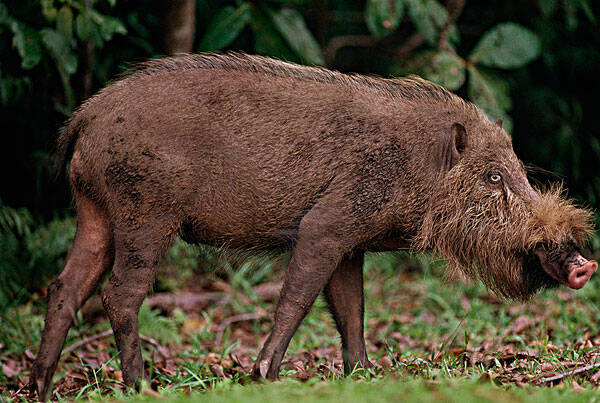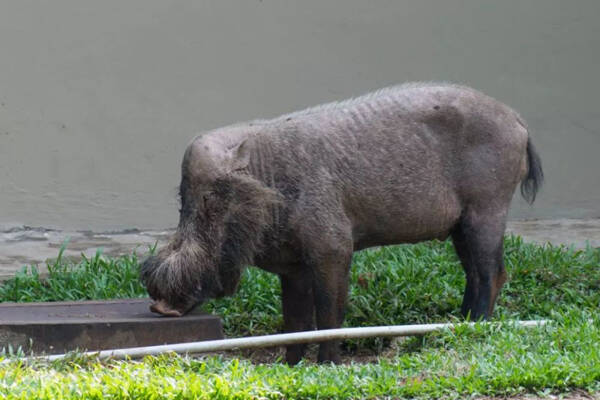Sus barbatus
IUCN
LCBasic Information
Scientific classification
- name:Sus barbatus
- Scientific Name:Sus barbatus,Bearded Pig,Western Bearded Pig
- Outline:Ungulata
- Family:Artiodactyla Suidae Sus
Vital signs
- length:122-148cm
- Weight:57-120kg
- lifetime:About 16 years
Feature
The head is large and the body is small, with a coarse, thick "beard" of hair on the bridge of the nose and cheeks.
Distribution and Habitat
Distributed in Brunei Darussalam, Indonesia (Kalimantan, Sumatra), Malaysia (Peninsular Malaysia, Sarawak, Sabah); possibly extinct: Philippines; extinct: Singapore.
Found in the Malay Peninsula, Riau Islands, Sumatra, Bangka Island, Borneo, southern Karimata Island, Sulu Archipelago, Balabac and Palawan's Sibutu and Tawitawi islands, and the Calamianislands in the western Philippines.
The main habitats are rainforests and mangroves. The moist evergreen rainforests include monsoon forests and mountain rainforests (also called cloud forests). Precipitation and day length vary with the seasons. These forests have an annual rainfall of 1,270 mm and dry and cold seasons, which are significantly different from equatorial rainforests. During the dry season, many trees lose their leaves or even all their leaves, and the "ladder" canopy decreases seasonally, allowing more sunlight to reach the ground. This increased sunlight promotes the growth of an understory shrub layer
Appearance
The Borneo Bearded Pig is a medium-sized artiodactyl, with males slightly larger than females. It is 122-148 cm long, 70-90 cm tall at the shoulder, 17-26 cm long tail, and weighs 57-83 kg, with the heaviest reaching 120 kg (rarely up to 200 kg). It is covered with coarse, sparse, long hair, light gray to brown-gray, or reddish brown, dark brown or very pale, depending on the region and individual circumstances. The mouth and nose are also hairy.
It has a large head and a small body, with the thinnest torso and the longest head of any pig, and small, pointed ears. There is a "beard" of coarse, dense hair on the bridge of the nose and cheeks. The beard is more pronounced in males and can be up to 15 cm long. The dark skin between the beard and the nose disc and around the eyes enhances the white color of the beard (usually yellow or silver). The face is elongated, with two small, small warts (tumor-like protrusions on the skin) on the cheeks of males, which are covered by t
Details
Borneo Bearded Pig (scientific name: Sus barbatus) is also known as Bearded Pig and Western Bearded Pig in foreign languages. It has two subspecies.

The Eurasian wild boar (Sus scrofa) shares the Bornean bearded pig's range in Malaya and Sumatra, but the Eurasian wild boar is smaller and lacks the Bornean bearded pig's distinctive facial hair. The Palawan bearded pig is smaller than the Bornean bearded pig and has a very limited range. Visually, the two can be distinguished by their whiskers, with the facial hair of the Palawan bearded pig being most developed on the lower jaw, while the hair of the Bornean bearded pig is densest on the bridge of the nose.
For most of the year, the Bornean bearded pig lives in a stable family group in one location. The extensive migrations they undertake are unique. Hundreds of animals are assembled for the migration. Yearlings have never been observed in the migrating herds, and probably for this reason, breeding is timed so that the yearlings grow up during the annual migration. The migrating herds are led by the old boar. At night they travel on wide paths that are well covered. During the day they retreat into the bush. The Bornean bearded pig always travels on the same route and at the same time of year. During the migrations, the Bornean bearded pig is less timid than usual. It is not clear whether these migrating herds cope with changes in food supply due to the regular migration cycle.
The Bornean bearded pig is usually most active in the morning and evening. Midday resting is spent wallowing in mud pools or sleeping. In areas populated by humans, they may turn nocturnal, especially when they are feeding on crop raids. The species often follows gibbons and macaques, feeding on fruit dropped or displaced by the primates. The species is an adept swimmer, including between oceanic islands, and has good climbing and jumping abilities even when young. The Bornean bearded pig has unusual population dynamics, with groups usually small and dispersed, but sometimes very large migratory groups of more than a hundred individuals are observed. These large-scale movements, which may cover 30-600 km, appear to be a response to the abundance of fruit ripening in the forest. Reproductive success is closely associated with good fruiting years, and the resulting explosive population expansion may force them to continue migrating in search of sufficient food. Moreover, such migrations are no longer observed in areas where more and more abundant fruit have been recorded.
The Bornean bearded pig uses its long snout to dig for earthworms and plant roots. Fruits and gum seedlings are also part of its diet. Some pigs often follow macaque groups to pick up fruits dropped by macaques. Along the coast, they also feed on dead fish. Omnivorous, they mainly feed on fruits, as well as plant roots, nuts and vegetation, and also eat animals such as invertebrates and carrion. The main predators are tigers, leopards, clouded leopards and pythons. The family group consists of sows and piglets, and because other females and piglets often join, larger groups are formed, with records of up to hundreds of people. Adult males usually act alone except for breeding.

Borneo bearded pigs, like other pigs, produce labial pheromones and saliva foam during courtship. During courtship, the boar chants while nudging the sow's flanks and sniffing her genital area. The boar repeatedly attempts to place his chin on the sow's rump. In a fully receptive sow, the boar rests his chin on her rump, stimulating the sow into a mating position. Copulation can last up to ten minutes, during which the spiral penis fits into the grooved cervix and a plug is formed after copulation. In the wild, the Bornean bearded pig generally breeds year-round, with a notable peak in mating activity when fruit trees finish their flowering cycle. This leads to farrowing when fruit is particularly abundant. The gestation period lasts approximately four months, with estimates of 90-120 days in the wild and ranging from 100-160 days in captivity. When a pregnant sow is ready to farrow, she leaves the group and builds a large, deep den high in the bush, which can be up to 1.8 meters in diameter and 1 meter in height. The den is made of fern leaves, twigs and dried palm leaves. The sow has five pairs of teats and gives birth to 7-9 piglets per litter. Small sows may give birth to only 3-4 piglets, while large, well-conditioned sows may give birth to 12 piglets.
The piglets' fur has a distinctive light-striped pattern, with a dark brown stripe down the middle of the back, and three light yellow and three dark brown stripes on each side of the body. The color begins to fade at about 5 weeks of age, and facial hair growth also begins at this time. Piglets remain in the nest for about 7-10 days after birth before following the sow's activities. The sow is very protective of her offspring and will hunt down any intruders, including other Bornean bearded pigs. Piglets begin to try solid food at a few weeks of age and are weaned at 3 months old, but piglets remain with the sow for about a year. When food is plentiful, a female can raise two litters in a year.
Although the Bornean bearded pig has declined in numbers due to habitat destruction, it is still quite common. The Bornean Bearded Pig is an easy prey for locals due to the lack of defense of the species during migration and its predictable time and migration route. Locals wait along the border of the Bornean Bearded Pig migration route and hunt them when they appear. These wild pigs travel in large groups, are relatively defenseless and cannot escape. They are used by locals as a reliable source of meat once a year.
Listed in the IUCN Red List of Threatened Species in 2016 ver 3.1 - Vulnerable (VU).
Protect wildlife and eliminate bushmeat.
Maintaining ecological balance is everyone's responsibility!








